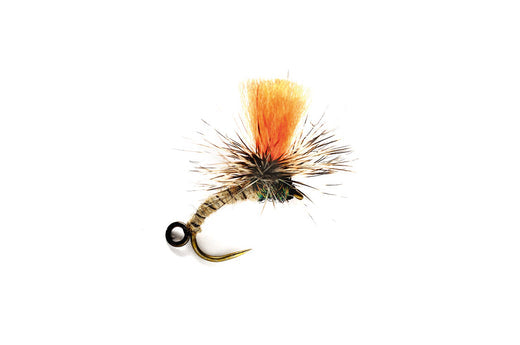This month’s fly of the month has been a favourite of ours for quite some time now. It was the first time we ever saw a tippet ring incorporated into a dry fly, which makes nothing but perfect sense. If you’d ever tied a dropper onto the bend of a barbless hook, you’ll know that there is a tendency for it to slide off, and this resolves that problem completely.
We recently got our hands on the book The Klink by Hans van Klinken, an absolute must read for all fly tyers. So, sticking with that theme and heading into winter, we thought we’d give you the low down on the Special Klinkhammer Duo from Fulling Mill. Winter might seem somewhat of a peculiar time to be featuring an emerger fly, however, although we will touch on why this pattern is effective, what makes this fly unique apart from the tippet ring, is the brightness and buoyancy of the yarn post. That makes this the ideal fly to use as an indicator.
In terms of fishing this pattern in winter, this is how we’d do it. To your floating line add a 9ft 4X tapered leader. Before you attach your tippet, add a tippet ring to the end of your leader. Then, add 2 to 4 foot of 5X fluorocarbon before attaching the Special Klinkhammer Duo. Once the fly is tied on, run another 1 to 3 foot of 5X fluoro from the tippet ring to your second fly, which will be a nymph of your choice. To make sure this rig fishes well, treat the post of your fly with floatant, and add deep soft weight to your tippet ring. This ensures your fly is able to suspend the nymph, even in a bit of choppy water, but the deep soft weight pulls down your tippet making sure no fish spook upon inspecting your dry.
Top tip: always add your floatant last, this will avoid any grease on your fingers rubbing off onto your leader or tippet, making it buoyant and visible.
In winter, you will no doubt have fish patrolling the shallows and margins. This is where this technique will prove deadly. Alternatively, if you have a windy day, fish it alongside any visible weed beds or even in open water. We’d consider using a nymph with a CDC collar, this will add life and movement as your dry fly drifts along the surface, suspending what might otherwise be a lifeless nymph. As to how long you need to make your dropper, this will be determined by the depth of the water you’re fishing. If you’re fishing gin clear water and the sun is high, then you can lengthen your leader from your fly line to your dry fly.
Over and above being a great indicator fly, the Duo Klink is a highly effective dry fly on it's own, for both yellowfish and trout alike. Emerger patterns aren't given enough credit, and are our go to dry flies when we see fish porpoising or feeding just sub surface when there aren't any visible terrestrials. The post ensures you can fish the fly all day without it sinking, but isn’t actually visible to the fish.
See below a step by step video on how to tie the Special Klinkhammer Duo. Visit our online store, for your Klinkhammer Duo Must Have's or pop into either our Sandton or Dullstroom shops for a cup of coffee and our expert tyers will help you select the materials you need!

